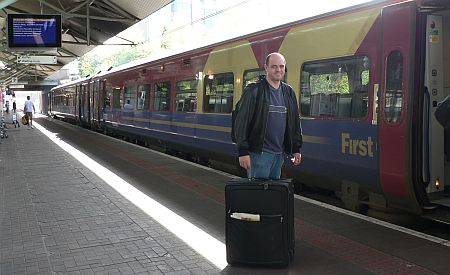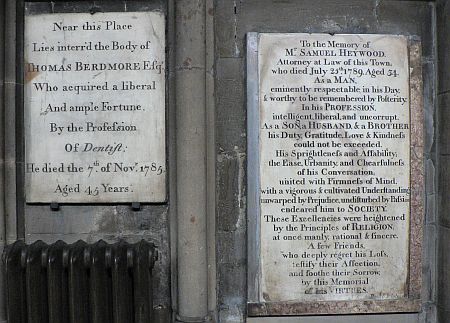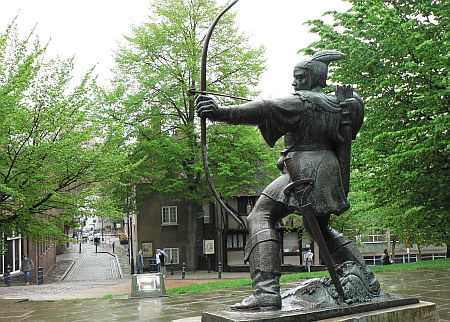Jane Jacobs passed away in April. This event was organized by John Sewell, a former mayor of Toronto, who was described as “disciple” of Jane. The ground floor of Trinity St. Paul’s Church was filled to standing room, and the balcony was about half full. The attendees seemed to include both people from the neighbourhood who had known Jane, as well as some had travelled from a longer distance.
- Mary Rowe, president and editor of Ideas That Matter, acted as the master of ceremonies for the evening. She said that Jane wouldn’t have liked this gathering if it was about her. She could, however, warm up to the gathering as a discussion of her ideas. Jane liked debate, and liked having people come to her house to discuss ideas.
- Ken Greenberg, former Director of Urban Design and Architecture for the City of Toronto, related Jane’s history, as she moved from New York to Toronto. Jane was offered honourary degrees multiple times, but chose to turn them down. Given a choice between celebrity and work, she chose work. Although many have pegged Jane as a pure urbanist, in recent years she spent a significant amount of time in the Toronto suburbs observing and trying to understand how they worked.
- Ann-Marie MacDonald, a Toronto-based writer and actor, read from Cities and the Wealth of Nations. She read a passage on import substitution, describing the roles that cities played in the a funeral in the south (i.e. the casket, clothes, nails, etc. all came from cities from the north).
- A quartet, led by Caitlin Brom-Jacobs (oboe) — Jane’s grand-daughter and a graduate of the Eastman School of Music — with Michelle Zapf-Belanger (violin), Carolyn Blackwell (viola) and Anne-Marie Zapf-Belanger (cello), played a Mozart Quartet for Oboe and Strings. The performance was quite moving, and the sound (from our seats in the balcony) was wonderful.
- A video montage of Jane including segments of her on the streets in Toronto wearing an afghan, and in conversation at home. She described the way she thought as web thinking — perhaps an emphasis on part-part interaction from systems thinking.
- Vince Pietropaolo, photographer and town planner, described a course from a college in upstate New York called Two Cities, which included a visit by students to New York City, and then to Toronto — ending up on Albany Street, where Jane lived. He read an article from The Village Voice on April 18, 1968 republished in Ideas That Matter: The Worlds of Jane Jacobs, where Jane disrupted a civic hearing, was arrested, and then released by police due to crowds calling for her freedom for two hours.
- Anne Collins, Jane’s editor from Random House Canada, said that she could hear Jane’s voice in her head but couldn’t quite reproduce the sound. Looking at the cover of Dark Age Ahead, she said that she wished that should could have convinced Jane to put her name on two lines, so that it would read Jane … Jacobs. She said that she was tempted to read from the footnotes, because they provide depth to the body of the chapters. Anne started reading from near the end of the book, and then made the joke that since she was Jane’s editor, she would skip over some of Jane’s explanation to read the final paragraph of the book.
- Max Allen, a producer from the CBC, introduced a recording of Jane’s 1979 Massey Lecture, that would become The Question of Separatism: Quebec and the Struggle Over Sovereignty. Max pointed out that the discussion on transfer payments is back in today’s headlines. In Canada, three of the provinces are clearly in surplus, and six are clearly in deficit, but Quebec is so close to balancing its books that its separation from Canada could potentially have minimal economics effects (on at least that dimension).
- The Flying Bulgar Klezmer Band played three tunes. David Buchbinder said that Jane had come to the release party of their third CD, not as a celebrity, but just as someone who was easy to talk with. Dave Wall made a quip that klezmer music can be appropriate for any occasion, because no one understands what the words are about. The final song had a dozen dancers in a chain prancing up and down the aisles between the pews.
- Margie Zeidler, recipient of the 2003 Jane Jacobs Prize, said that she would give the perspective of a 10-year, since she had known Jane for 30 years. Jane was first introduced as a famous writer, but since Jane didn’t write Nancy Drew novels, Margie wasn’t impressed. They had many conversations where Jane was quite interested in listening to Margie’s thoughts, and Jane occasionally chiding Margie when she wasn’t thinking straight.
- John Sewell read from Systems of Survival, at the point at which Kate describes how she came about to categorize behaviours into commercial and guardian syndromes. This emphasized a difference that, unlike other animals, human beings can be commercial.
- R. H. Thomson, a renowned actor, described how after being away for a few weeks in other places, he comes home twice: once to his wife, two sons and dog, and then to Bloor Street, where he knows the shopkeepers. He read from The Death and Life of Great American Cities, where Jane describes an entire day on Hudson Street in New York, where she used to live.
- Mike Ford, on guitar and then piano, performed two songs. In “Stars shone on Toronto”, he described a peaceful city in the darkness of a power failure. He then sang “Crossroads”– written for the Ideas That Matter conference in 1997 — which includes the lines …
- The world’s at a crossroads — this town’s at a crossroads
Jane Jacobs help us decide how it unfolds and what we should do … - The evening closed with a second video montage of Jane at her typewriter and pulling sheets from her stacks of notes. Jane said that she was most proud of her work in Cities and the Wealth of Nations, because that was her largest intellectual contribution.
with the audience singing along in the choruses.
I see that there’s supposed to be a similar event in New York on June 28, but can’t quite get all of the details.
In doing the searches for web links for this posting, I note that Ideas That Matter volume 3, number 3 includes commentary on Dark Age Ahead, as well as some other authors that I wouldn’t have expected in traditional pegging of Jane Jacob’s work as “urban planning”. These include Robert Lucas (1995 Nobel Laureate in economics) and Henry Mintzberg (from management). I think that I’ll take a break and read a bit more ….









